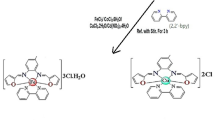Abstract
The indiscriminate use of antifungal agents has led to the advancement of microorganisms tolerant to the various drugs known in the market. Therefore, the search for new compounds and new technologies capable of giving more stable formulations and better pharmacological activities is of paramount importance as an alternative for the development of new therapeutics. However, its effectiveness is directly related to the knowledge of its characteristics in the solid state. Thus, the objective of this work was evaluating the thermal behavior, physicochemical aspects and microbiological of the complexes of inclusion of β-cyclodextrin (BCD) and biphenyl-4-methyl carboxylate (B4CMET). Therefore, differential scanning calorimetry, thermogravimetry, Fourier-transformed infrared spectroscopy, X-ray diffraction and microbiological assay were used to generate robust fingerprint of the inclusion complexes. The results showed the formation of inclusion complexes of B4CMET with βCD, thereby stressing its greater stability and potential use as an antifungal agent against Candida spp. Thus, with thermoanalytical techniques it was possible to observe the increased thermal stability, with FTIR changes of characteristic bands were verified, with XRD the disappearance of diffraction peaks of the B4CMET was verified, and with the microbiological assay it was possible to visualize increased antifungal activity.




Similar content being viewed by others
References
Ferronatto R, Marchesan ED, Pezenti E, Bednarski F, Onofre SB. Atividade antimicrobiana de óleos essenciais produzidos por Baccharis dracunculifolia D.C. e Baccharis uncinella D.C. (Asteraceae). Rev Bras Farmacogn. 2007;17:224–30.
Deus RJA, Alves CN, Arruda MSP. Avaliação do efeito antifúngico do óleo resina e do óleo essencial de copaíba (Copaifera multijuga Hayne). Bras Pl Med. 2011;13:1–7.
Maggio RM, Calvo NL, Vignaduzzo SE, Kaufman TS. Pharmaceutical impurities and degradation products: uses and applications of NMR techniques. J Pharm Biomed Anal. 2014;101:102–22.
Koradia V, Diego HL, Frydenvang K, Ringkjøbing-Elema M, Bond A, Müllertz A, Rantanen J. Solid forms of amlodipine besylate: physicochemical, structural and thermodynamic characterization. Cryst Growth Des. 2010;10:5279–90.
Moura EA, Correia LP, Pinto MF, Procópio JVV, Souza FS, Macedo RO. Thermal characterization of the solid state and raw material fluconazole by thermal analysis and pyrolysis coupled to GC/MS. J Therm Anal Calorim. 2010;100:289–93.
Böer TM, Procópio JV, Nascimento TG, Macêdo RO. Correlation of thermal analysis and pyrolysis coupled to GC–MS in the characterization of tacrolimus. J Pharm Biomed. 2013;73:18–23.
Daneluti ALM, Matos JR. Study of thermal behavior of phytic acid. Braz J Pharm Sci. 2013;49:275–83.
Sangeetha MK, Mariappan M, Madhurambal G, Mojumdar SC. TG–DTA, XRD, SEM, EDX, UV, and FT-IR spectroscopic studies of l-valine thiourea mixed crystal. J Therm Anal Calorim. 2015;119:907–13.
Lyra MAM, Alves LDS, Fontes DAF, Soares-Sobrinho JL, Rolim-Neto PJ. Ferramentas analíticas aplicadas à caracterização de complexos de inclusão fármaco-ciclodextrina. Rev Ciênc Farm Básica Apl. 2010;31:117–24.
Ford JL, Mann TE. Fast-scan DSC and its role in pharmaceutical physical form characterisation and selection. Adv Drug Deliv Rev. 2012;64:422–30.
Guan Y, Wang C, Wang D, Dang G, Chen C, Zhou H, Zhao X. High transparent polyimides containing pyridine and biphenyl units: synthesis, thermal, mechanical, crystal and optical properties. Polymer. 2015;62:1–10.
Silva Júnior WF, Pinheiro JGO, Pinheiro CDLFAM, Barbosa ALREG, Lima ES, Veiga Júnior VF, Silva Júnior AA, Aragão CFS, Lima AAN. Thermal behavior and thermal degradation kinetic parameters of triterpene α, β amyrin. J Therm Anal Calorim. 2017;127:1757–66.
Yang H, Huang Z, Huang Y, Dong W, Pan Z, Wang L. Characterization of Chinese crude propolis by pyrolysis gaschromatography/mass spectrometry. J Anal Appl Pyrolysis. 2015;113:158–64.
Tolu J, Gerber L, Boily J-F, Bindlera R. High-throughput characterization of sediment organic matter by pyrolysis–gas chromatography/mass spectrometry and multivariate curve resolution: a promising analytical tool in (paleo)limnology. Anal Chim Acta. 2015;880:93–102.
Ge S, Xu Y, Tian Z, She S, Huang L, Zhang Z, Hu Y, Weng J, Cao M, Sheng L. Pyrolysis study of pectin by tunable synchrotron vacuum ultraviolet photoionization mass spectrometry. J Therm Anal Calorim. 2015;120:1399–1405.
Kusch P, Rieser C, Knupp G, Mang T. Characterization of copolymers of methacrylic acid with poly(ethylene glycol) methyl ether methacrylate macromonomersby analytical pyrolysis–gas chromatography/mass spectrometry(Py–GC/MS). J Anal Appl Pyrolysis. 2015. https://doi.org/10.1016/j.jaap.2015.03.003.
Vianna-Filho RP, Petkowicz CL, Silveira JL. Rheological characterization of O/W emulsions incorporated with neutral and charged polysaccharides. Carbohydr Polym. 2013;93:266–72.
Amorim SR, Klier AH, Angelis LH. Controle de qualidade na indústria farmacêutica: identificação de substâncias por espectroscopia no infravermelho. Rev Bras Farm. 2013;94:234–42.
CLSI. Reference method for broth dilution antifungal susceptibility testing of yeasts. CLSI Document M27A3. 3 ed. v.28. n.14. Wayne, PA, USA, 2008.
Serafini MR, Menezes PP, Costa LP, Lima CM, Quintans LJ Jr, Cardoso JC, Matos JR, Soares-Sobrinho JL, Grangeiro S Jr, Nunes PS, Bonjadim LR, Araújo AAS. Interaction of p-cymene with b-cyclodextrin. J Therm Anal Calorim. 2012;109:951–5.
Menezes PP, Serafini MR, Quintans-Júnior LJ, Silva GF, Oliveira JF, Carvalho FMS, Souza JCC, Matos JR, Alves PB, Matos IL, Hădărugă DI, Araújo AAS. Inclusion complex of (2)-linalool and b-cyclodextrin. J Therm Anal Calorim. 2014;115:2429–437.
Abarca RL, Rodríguez FJ, Guarda A, Galotto MJ, Bruna JE. Characterization of beta-cyclodextrin inclusion complexes containing an essential oil component. Food Chem. 2016;196:968–75.
Jadhav P, Pore Y. Physicochemical, thermodynamic and analytical studies on binary and ternary inclusion complexes of bosentan with hydroxypropyl-β-cyclodextrin. Bull Fac Pharm Cairo Univ. 2017;55:147–84.
Xua J, Zhanga Y, Lia X, Zheng Y. Inclusion complex of nateglinide with sulfobutyl ether β-cyclodextrin: preparation, characterization and water solubility. J Mol Struct. 2017;1141:328–34.
Cunha-Filho MSS, Sá-Barreto LCL. Utilização de ciclodextrinas na formação de complexos de inclusão de interesse farmacêutico. Rev Ciênc Farm Básica Apl. 2007;28:1–9.
Kfoury M, Sahraoui AL-H, Bourdon N, Laruelle F, Fontaine J, Auezova L, Greige-Gerges H, Fourmentin S. Solubility, photostability and antifungal activity of phenylpropanoids encapsulated in cyclodextrins. Food Chem. 2016;196:518–25.
Zhang S, Zhang H, Xu Z, Wu M, Xia W, Zhang W. Chimonanthus praecox extract/cyclodextrin inclusion complexes: selective inclusion, enhancement of antioxidant activity and thermal stability. Ind Crop Prod. 2017;95:60–5.
Author information
Authors and Affiliations
Corresponding author
Rights and permissions
About this article
Cite this article
de Lima Ramos Júnior, F.J., da Silva, K.M.A., Brandão, D.O. et al. Investigation of the thermal behavior of inclusion complexes with antifungal activity. J Therm Anal Calorim 133, 641–648 (2018). https://doi.org/10.1007/s10973-018-7040-2
Received:
Accepted:
Published:
Issue Date:
DOI: https://doi.org/10.1007/s10973-018-7040-2




